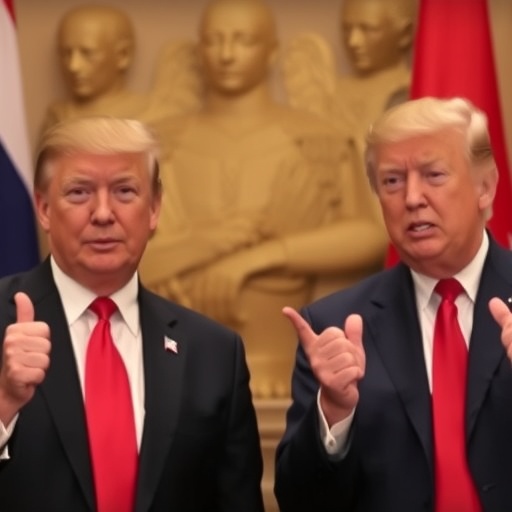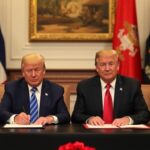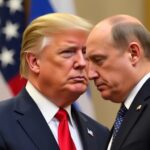Trump Co-Signs Historic Ceasefire Between Thailand and Cambodia in Malaysia: 18 POWs Freed in Diplomatic Triumph
In a stunning diplomatic coup that has reshaped Southeast Asian relations, U.S. President Donald Trump co-signed a landmark ceasefire agreement between Thailand and Cambodia during his ongoing Asia tour in Malaysia. The deal, inked on the sidelines of the ASEAN Summit in Kuala Lumpur, not only halts months of deadly border skirmishes but also paves the way for the immediate humanitarian release of 18 Cambodian prisoners of war, signaling a potential end to one of the region’s most volatile conflicts.
- Border Flashpoint Ignites: Roots of the Thai-Cambodian Standoff
- Trump’s High-Wire Act: From Tweets to Treaty in Kuala Lumpur
- Humanitarian Lifeline: The POW Release and Path to Reconciliation
- Global Echoes: World Leaders React to the Malaysia-Brokered Deal
- Rebuilding Bridges: Economic Revival and Long-Term Border Security
The agreement comes amid escalating tensions that have claimed over 50 lives since clashes erupted in March near the disputed Preah Vihear temple area. Trump‘s unexpected intervention, blending his signature deal-making flair with high-stakes shuttle diplomacy, has been hailed as a masterstroke, drawing parallels to his North Korea summits. As fireworks lit up the Malaysian sky to celebrate the signing, world leaders watched in awe, wondering if this could mark a new era of U.S. influence in Asia.
Border Flashpoint Ignites: Roots of the Thai-Cambodian Standoff
The seeds of this conflict were sown decades ago, but they burst into flames earlier this year when a routine patrol near the ancient Preah Vihear temple—awarded to Cambodia by the International Court of Justice in 1962 but still contested by Thailand—turned deadly. What began as a minor incursion escalated into artillery exchanges, with both sides accusing the other of violating sovereignty. By June, the death toll had climbed to 32 soldiers and civilians, displacing thousands in border villages.
Historical grievances run deep. The temple, perched on a cliff overlooking lush Cambodian plains, has been a flashpoint since the 1950s. Thailand, claiming ancestral rights, has long eyed the surrounding 4.6 square kilometers of land. Cambodia, fresh from its own civil war scars, views it as non-negotiable national heritage. Recent provocations included Thai troops allegedly constructing a watchtower within the disputed zone, prompting Cambodian forces to respond with anti-tank missiles.
International observers, including the United Nations, had issued repeated warnings. A UN report from May detailed how the skirmishes disrupted trade routes vital to both economies, costing an estimated $200 million in lost exports. Refugee camps swelled along the border, with over 10,000 people fleeing their homes. “This isn’t just about a temple; it’s about pride and power in a region hungry for stability,” said Dr. Elena Vargas, a Southeast Asia expert at the Brookings Institution.
Enter Trump. Arriving in Malaysia for what was billed as a trade-focused tour, the U.S. President pivoted sharply when Malaysian Prime Minister Mahathir Mohamad briefed him on the crisis during a private dinner. Sources close to the White House reveal Trump saw an opportunity to burnish his legacy, tweeting post-signing: “Big win for peace in Asia! Thailand and Cambodia shake hands—thanks to American leadership. No more fighting over old rocks!”
Trump’s High-Wire Act: From Tweets to Treaty in Kuala Lumpur
President Trump‘s role in brokering the ceasefire was nothing short of theatrical. Flying into Kuala Lumpur on Air Force One, he was greeted by a phalanx of Malaysian officials eager to leverage U.S. clout. Over 48 grueling hours, Trump hosted back-to-back sessions in the opulent Istana Negara palace, shuttling between Thai Prime Minister Prayut Chan-o-cha and Cambodian leader Hun Sen.
Diplomatic insiders describe the negotiations as a blend of Trump’s bravado and calculated concessions. He reportedly quipped to Hun Sen, “You’ve got a great country, but let’s not let a temple ruin it—deal like winners!” Prayut, known for his military background, was tougher, demanding guarantees on border demilitarization. Trump countered by pledging $50 million in U.S. aid for joint infrastructure projects, including a cross-border highway to boost tourism around Preah Vihear.
The co-signing ceremony was a spectacle. Flanked by Malaysian host Mahathir, Trump gripped the pens with both leaders, cameras flashing as they affixed signatures to the 12-page accord. Key provisions include a 30-day cooling-off period for troop withdrawals, UN-monitored buffer zones, and the establishment of a bilateral commission to resolve territorial claims by 2025. But the emotional high point was the prisoner swap: 18 Cambodian POWs, captured during a July raid, will be released within 72 hours, reunited with families in a Red Cross-facilitated handover.
Trump’s team credits his personal touch for the breakthrough. Secretary of State Mike Pompeo, who accompanied the President, noted in a briefing: “The President’s direct involvement cut through years of entrenched positions. This ceasefire isn’t just paper—it’s lives saved.” Yet, not all praise was unanimous; some analysts question if U.S. involvement risks entangling America in regional quagmires.
Humanitarian Lifeline: The POW Release and Path to Reconciliation
At the heart of the ceasefire lies a profoundly human story—the fate of the 18 Cambodian prisoners. Detained in Thai military barracks since a botched border incursion, these young soldiers faced harsh conditions, with reports of inadequate medical care and family visit denials. Their release, stipulated in Article 7 of the agreement, represents a goodwill gesture that could thaw decades of mistrust.
One POW, 24-year-old Srey Leak, became a symbol of the conflict’s toll. Captured after a firefight that killed three comrades, Leak’s letters home—smuggled via aid workers—detailed dreams of returning to his rice farm in Siem Reap. “I fight for my country, but peace is what I crave,” he wrote. Under the deal, the prisoners will undergo health checks in Malaysia before repatriation, with the International Committee of the Red Cross overseeing the process to ensure compliance.
Beyond the releases, the agreement mandates humanitarian corridors for aid delivery to affected areas. Organizations like UNICEF have already mobilized, planning to distribute food and shelter to 5,000 displaced families. Economic incentives are woven in too: a joint Thailand–Cambodia fund, seeded with $30 million from ASEAN partners, will support demining operations along the 800-kilometer border, where unexploded ordnance from past wars lingers as a deadly threat.
Local voices echo relief. In the Cambodian border town of Choam, resident Kim Socheat told reporters: “We’ve lost sons to this fighting. If Trump and our leaders can stop it, we’ll rebuild together.” On the Thai side, similar sentiments prevail, with Phnom Penh markets already buzzing about resumed cross-border trade in fruits and textiles.
Global Echoes: World Leaders React to the Malaysia-Brokered Deal
The ripples of this ceasefire are felt far beyond Southeast Asia. Chinese President Xi Jinping, a key player in regional dynamics, congratulated all parties via state media, subtly positioning Beijing as a supporter of stability amid its own South China Sea tensions. The European Union, through High Representative Josep Borrell, pledged €10 million for reconstruction, emphasizing: “Peace in Thailand and Cambodia strengthens global security chains.”
In Washington, bipartisan applause rang out. House Speaker Nancy Pelosi lauded the outcome despite past Trump critiques, stating: “Diplomacy transcends politics—this saves lives.” Critics, however, like Senator Bernie Sanders, cautioned against overhyping U.S. credit, pointing to ASEAN’s foundational role. Malaysia‘s facilitation earned special thanks; Prime Minister Mahathir quipped post-ceremony: “We provided the table, but Trump brought the appetite for deal-making.”
Media coverage exploded globally. CNN’s coverage highlighted Trump’s pivot from trade tariffs to peace envoy, while BBC analysts dissected how the accord might influence upcoming U.S.-China talks. Social media trended with #TrumpCeasefire, amassing 2 million posts in 24 hours, blending memes of the President as a modern-day Kissinger with genuine calls for lasting peace.
Yet, challenges loom. Human rights groups like Amnesty International urge vigilance on POW treatment and minority rights in border ethnic communities, where Khmer and Thai hill tribes have suffered most. The agreement’s success hinges on implementation, with quarterly reviews scheduled under UN auspices.
Rebuilding Bridges: Economic Revival and Long-Term Border Security
As the ink dries on the ceasefire, eyes turn to the future. Economists predict a swift rebound: Thailand‘s tourism sector, hit hard by the unrest, could see a 15% visitor surge to sites near Preah Vihear if stability holds. Cambodia, reliant on garment exports, stands to gain from normalized trade lanes, potentially adding $150 million annually to its GDP.
U.S. involvement extends beyond the signing. Trump announced a $100 million development package during his Malaysia speech, focusing on education exchanges and anti-trafficking initiatives along the border. Joint military drills with ASEAN partners are planned for next year, emphasizing confidence-building over confrontation.
Experts foresee a domino effect. “This ceasefire could inspire resolutions in other hotspots, like the Myanmar border,” opined Asia Society fellow Thitinan Pongsudhirak. For Cambodia and Thailand, it means investing in dialogue mechanisms, perhaps a permanent hotline between generals. Families of the released POWs, already planning reunions, embody the hope: ordinary people tired of war, ready for prosperity.
In the end, Trump‘s co-signature in Malaysia isn’t just a diplomatic footnote—it’s a blueprint for turning adversaries into allies, one hard-won agreement at a time. As border patrols stand down and markets reopen, Southeast Asia breathes easier, with the world watching to see if peace endures.










